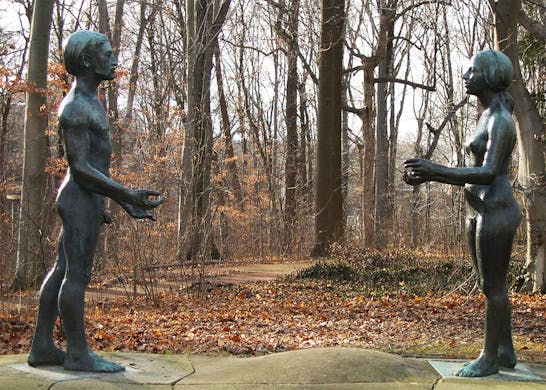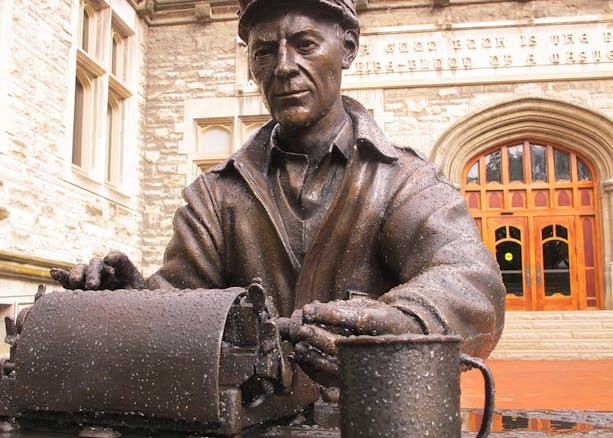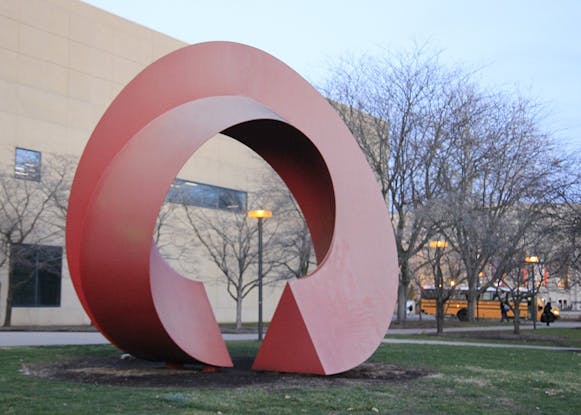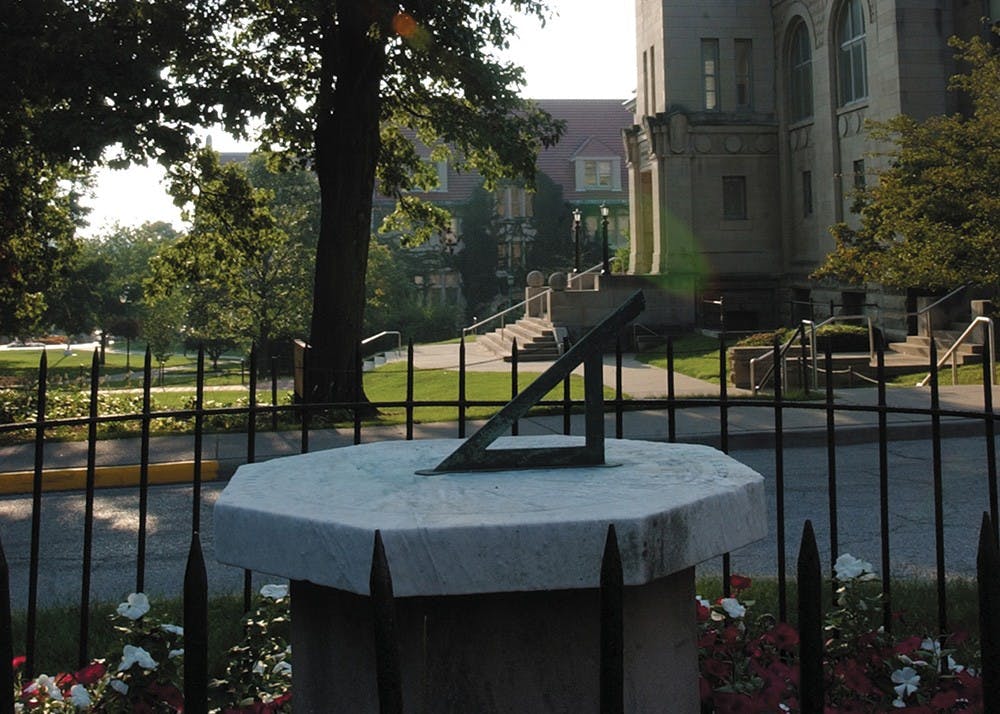Sundial
A remnant from the original IU campus at Seminary Square in downtown Bloomington, the sundial, which now lies in the crescent between Maxwell Hall and the Frances Morgan Swain Student Building, was erected in 1868. It was used to mark time according to where the sun was, Schwier explained.
It was moved to the Dunn’s Wood campus in 1896, 13 years after much of the Seminary Square campus burned down. The sundial is famously where Mathilda and Otto Klopsch, both graduates of the class of 1896, met. They married in 1896, the year the sundial was finally moved.
In remembrance of where they first met, they were given permission by former President William Lowe Bryan to spread their ashes on the Old Crescent timepiece.
A plaque by the sundial reminds visitors where the couple began their romance.
The Space Between: Adam and Eve by Jean-Paul Darriau

The Space Between by internationally recognized IU art professor Jean-Paul Darriau, 1929-2006, is a bronze sculpture of nude Adam and Eve reaching out to each other resting on the eastern edge on Dunn’s Woods across from Kirkwood Hall.
Completed in 1968, legend has it that Darriau used his own children as models, according to "Indiana University Bloomington: America’s Legacy Campus."
Sherry Rouse, IU art curator, said Darriau wanted viewers to see them separately rather than together. The statues represent the differences between men and women, but show how they're drawn together by love.
Rouse also said the statues’ nudity was a source of controversy. At one point, someone even sawed off Adam's penis, making Darriau craft a new one.
As a joke, for decades now, IU students have dressed up the Adam and Eve statues in the latest styles.
Hoagy Carmichael sculpture by Michael McAuley

The statue of songwriter and IU alumnus Hoagy Carmichael by Michael McAuley is situated outside the IU Cinema along the northeast side of the IU Auditorium.
Hoagy is portrayed at his grand piano, jacket tossed off, his left hand on a folder of past compositions and his right hand hovering about the keyboard, working on “Memphis in June,” according to McAuley’s own description.
McAuley unveiled his statue of Carmichael at the Indy Jazz Fest in Bloomington in 2007.
After obtaining his law degree from IU in 1926, Carmichael became a key figure in the American music scene. Among the Oscar winner’s notable compositions are “Georgia on my Mind,” “In the Cool, Cool, Cool of the Evening” and “Chimes of Indiana,” which was inspired by the ringing bells of IU’s student building, according to "Indiana University Bloomington: America’s Legacy Campus."
Ernie Pyle by Harold Langland

Harold "Tuck” Langland’s statue near the Sample Gates of IU alumnus and noted World War II journalist Ernie Pyle was commissioned in 2013 for the inauguration of the Media School. It was dedicated the following year on homecoming weekend. Langland, an IU-South Bend professor, portrayed a bronze, life-sized Pyle at his typewriter wearing a bomber jacket, helmet and goggles. A coffee cup is nearby.
According to "Indiana University Bloomington: America’s Legacy Campus," the statue is meant to “convey how Pyle worked alongside foot soldiers at the front during World War II.”
Just before finishing his degree, Pyle left IU to pursue a career in journalism, eventually becoming a war correspondent. He won a Pulitzer Prize for his first-person stories about infantry soldiers on World War II battlefields.
He died when he was hit by machine gun fire during the Battle of Okinawa in Japan.
About Pyle, former President Harry Truman said that, “No man in this war has so well told the story of the American fighting man as American fighting men wanted it told,” according to "Indiana University Bloomington: America’s Legacy Campus."
Indiana Arc by Charles Perry

The giant, red 21-foot Indiana Arc, situated by the Sidney and Lois Eskenazi Museum of Art, was dedicated in 1995. It was commissioned to stand aside architect I.M. Pei’s art museum and to honor the presidency of Thomas Ehrlich, according to "Indiana University Bloomington: America’s Legacy Campus."
Perry, whose work can be seen around the world including Singapore, Australia, Saudi Arabia and the National Air and Space Museum in Washington, D.C., got the job.
These are just a few of IU’s statues and their history. Schwier noted that many of the campus art work is homegrown, designed and sculpted by IU faculty. “We have an amazing art department here,” Schwier said.
She said that public art is an integral part of the campus.
“I think it is intended to make the campus more appealing to those of us who inhabit it. It’s more homelike,” Schwier said. “I know there’s lots of educational theory out there about if where you are occupying is beautiful, it inspires creativity in your own work, in your research, and productivity, and that kind of thing.”




